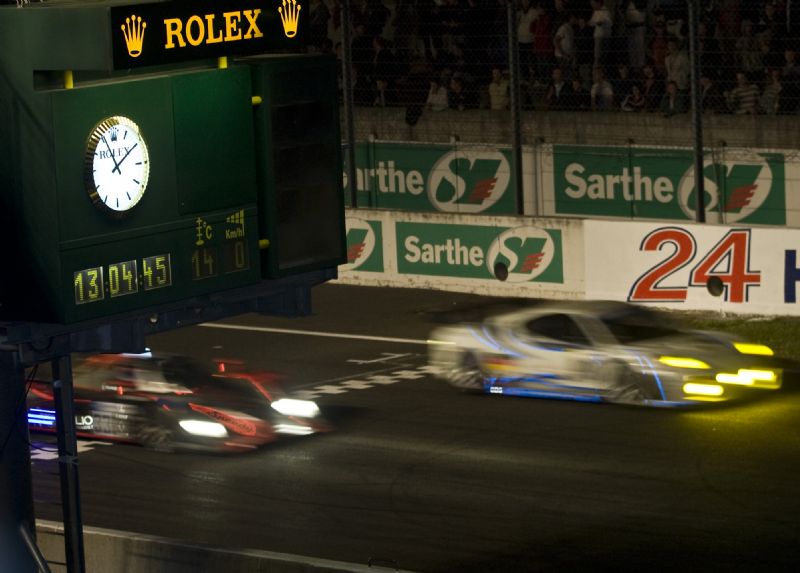A journey through the night at LeMans
 |
| Cars race through the night in France |
| Rolex |
The 24 Heures du Mans are always held the weekend closest to the shortest night of the year in France, the 21st of June. In fact, there is something magic about the moment the race passes from day into night- it becomes a wholly different challenge, and as they say, it is the stuff that legends are made of.
For all the 24 Heures du Mans participants, drivers as well as spectators, the change from day to night, and the excitement of dawn breaking is all part of the legend of 24 Heures du Mans. Each of the 3,000 journalists and thousands of spectators are welcomed into the 77,000m2 reception area (equivalent to seven Stades de France next to each other). The circuit also boasts 18,000m2 of commercial areas and the campers are spread throughout 125 hectares of camp sites (twice the area of the Disneyland Paris park).
Over 250,000 spectators attend the event during the three days and the French fans are joined by 40,000 British, 20,000 Danes, 10,000 Dutch and many more from all around the world, all united to witness the spectacular 24 Heures du Mans.
To ensure that all spectators have a memorable and safe time, a body of 2,000 officials, 2,000 marshals and track-side officials, 400 first-aid specialists and 100 doctors are ready to take action at the wheel of any of the 300 ambulances on site.
Some personalities are particularly known for their ways of passing the time throughout the night of Les 24 Heures du Mans. Paul Frère, born January 20th, 1917 in Le Havre, France, and known as a famous Belgian journalist and former driver who had played his part in no less than fifty-one 24 Heures du Mans races, passed away on February 23rd, 2008. Everyone knew and admired the gentleman, journalist and driver who had, like anyone, his own personal habits and idiosyncrasies. Once he had seen the start of Les 24 Heures du Mans from the media centre, he would spend the first part of the night in the garages with the team mechanics. At around 3am he would always retire to his Porsche, parked in P6, as close as possible to the paddock. He would get in the car, turn on the radio and rest his eyes- resisting sleep- © listening the dulcet tones of Bruno Vandestick's commentary, before being stirred as the sun began to rise again at 5am. Then he would put on a fresh sky-blue shirt and make his way to his desk, 1.019 in the media centre, where there is now a commemorative plate in his honor.
Meanwhile, that same night occurring every year during Les 24 Heures du Mans, Herb Fishel, the head of sport at General Motors, always spends the first few hours of the race in the team bus area where he would use the same strategy to rest, © dosing off with the radio blaring, ready to jump into action at a moment's notice. At the time, he would sleep on the uncomfortable seats of the General Motors team bus. Now-a-days one could offer him a soundproofed sleeping car, just like the one put at the disposal of all the drivers, doctors and nurses.
His worst 24 Heures du Mans memory dates back ten years to the night of Ron Fellows' accident. The Corvette hit the tire barriers before the second chicane and was completely destroyed. Race director Daniel Poinsenot immediately gave the team access to the video of the disaster as nobody could tell the exact location of the accident- it turned out to be in a remote corner of the circuit. Race control took action and sent one of its personal motorcycles to transport Herb Fishel and the rescue teams to the presumed location of the accident. The only way to access the site was through a campsite, following a trail through thick wood and bushes.
The safety crews immediately dispatched their nitrogen bottles to dry out the spilled oil. They gathered all the debris of the destroyed car and the doctors attended to the driver, fortunately and amazingly uninjured. The rescue operation continued under weak lamplight, and the car was eventually rebuilt in the garage, resuming the race at dawn.
However, in all of this, one of the most powerful images to emerge from the night of the 24 Heures du Mans that year was the footage of the massive organization that works throughout the whole night to keep things together. That considerable effort of all of those people combined is what ensures the race and the spectator entertainment (this year to include a concert by Mademoiselle K and Star Sailor) can continue to be enjoyed by everyone.
This is one of the most impressive aspects of the 24 Heures du Mans and it is something that does not change from year to year, allowing everyone to enjoy this legendary event.
It was just today, June 14th, at 3pm that 55 teams began the 2008 24 Heures du Mans following the Rolex countdown.
Rolex has been the Official Timekeeper for Les 24 Heures du Mans and the Le Mans Series since 2001 and 2005 respectively. In North America, Rolex has been a partner of the Rolex 24 At Daytona since 1959.
